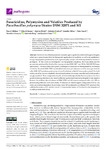Fusaricidins, Polymyxins and Volatiles Produced by Paenibacillus polymyxa Strains DSM 32871 and M1
Mülner, Pascal
Schwarz, Elisa
Dietel, Kristin
Herfort, Stefanie
Jähne, Jennifer
Lasch, Peter
Cernava, Tomislav
Berg, Gabriele
Vater, Joachim
Paenibacilli are efficient producers of potent agents against bacterial and fungal pathogens,
which are of great interest both for therapeutic applications in medicine as well as in agrobiotechnology.
Lipopeptides produced by such organisms play a major role in their potential to inactivate
pathogens. In this work we investigated two lipopeptide complexes, the fusaricidins and the
polymyxins, produced by Paenibacillus polymyxa strains DSM 32871 and M1 by MALDI-TOF mass
spectrometry. The fusaricidins show potent antifungal activities and are distinguished by an unusual
variability. For strain DSM 32871 we identified numerous yet unknown variants mass spectrometrically.
DSM 32871 produces polymyxins of type E (colistins), while M1 forms polymyxins P. For both
strains, novel but not yet completely characterized polymyxin species were detected, which possibly
are glycosylated. These compounds may be of interest therapeutically, because polymyxins have
gained increasing attention as last-resort antibiotics against multiresistant pathogenic Gram-negative
bacteria. In addition, the volatilomes of DSM 32781 and M1 were investigated with a GC–MS approach
using different cultivation media. Production of volatile organic compounds (VOCs) was
strain and medium dependent. In particular, strain M1 manifested as an efficient VOC-producer that
exhibited formation of 25 volatiles in total. A characteristic feature of Paenibacilli is the formation of
volatile pyrazine derivatives.
Files in this item

